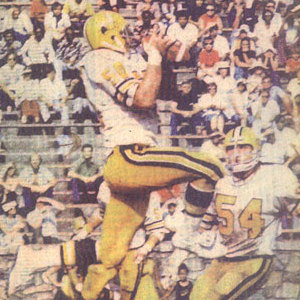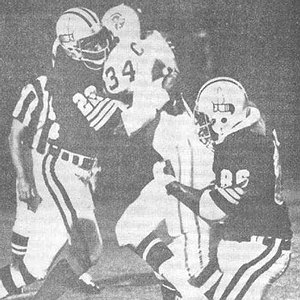

Charlotte
WFL
Hornets
- 1975
With negotiations to rehire 1974 head coach Vito “Babe” Parilli at an impasse, Bell was forced to make the Memphis Southmen’s 1974 running backs coach Bob Gibson his new head man less than two months prior to the start of the ’75 season. Gibson had made his name as the head coach at Bowling Green (Ohio) University and then went to the CFL as Toronto’s offensive backfield coach. He served in the same capacity with the 1974 Southmen until signing with the Hornets in May of 1975. Two members of this four man staff went on to NFL coaching recognition. Linebacker coach Herb Paterra had been an All Big Ten linebacker at Michigan State and played middle linebacker for the Buffalo Bills from 1962-’65 until going to the Hamilton Tiger Cats of the CFL and helping them to two Grey Cup Championships in 1965 and 1967. He was a highly respected linebacker coach at a number of colleges until joining Gibson’s staff. Life after the WFL proved productive with stops at the Rams, Bills, and Detroit Lions as defensive coordinator and additional linebacker coaching positions with Tampa Bay and Green Bay. Paterra is still at it, serving as Associate Head Coach on Hal Mumme’s staff at New Mexico State University. Gibson’s defensive backfield coach Lindy Infante parlayed a brief CFL career, time as the head coach at his high school alma mater Miami (FL) Senior H.S., and a stint as Florida’s freshman team coach and varsity backfield coach into the defensive coordinator’s job at Memphis State. Success there led him to the Hornets and in later years he was off to Tulane and then his first job in the NFL with the N.Y. Giants. He received credit for developing Ken Anderson as the offensive coordinator of the Bengals before taking his first head-coaching job with the Jacksonville Bulls of the USFL for 1984 and ‘85. He became Head Coach of the Green Bay Packers from 1988-1991 and later with the Indianapolis Colts in 1996 and ’97.
The 1974 Stars/Hornets quarterback Tom Sherman retained the position in 1975 despite the staff’s belief that former Yale star Brian Dowling could overtake him. Dowling had been an 11th round choice of the Vikings in 1969 but played the season with the Bridgeport Jets of the Atlantic Coast Football League. He finally made it back to the NFL with the Patriots but threw only fifty-four passes in all of 1972 and 1973. He did marginally better with the 1975 Hornets, attempting fifty-five passes! He managed to throw one pass which fell incomplete, for the 1977 Packers and Dowling’s pro career was completed. He remained most famous for being Calvin Hill’s teammate at Yale and having the Doonesbury comic strip character, football hero B.D. modeled after him. The Stars/Hornets leading scorer in 1974, running back Don Highsmith returned for another year. Highsmith originally attended Michigan State as a scholarship track athlete, a sprinter who decided to go out for football. He was drafted in the 13th round in 1970 by the Oakland Raiders and remained with them through the 1972 season before playing in Green Bay for ’73. Highsmith would lead the Hornets 1975 contingent in both rushing and scoring. After three training camps and two seasons with the Houston Oilers, fullback Lewis Jolley out of North Carolina proved to be an effective blocker for Highsmith and a dependable ball carrier when given the chance. Jolley was somewhat used to playing second fiddle. At North Carolina he remained in the shadow of running mate Don McCauly who was the Colts number one draft choice in 1971 after a record setting Tarheel career that he had prepped for at Long Island’s Garden City High School. He was effective in 1974 and repeated his role in ’75. John Sykes was the only other running back who posed an offensive threat for the Hornets. He was hailed as “the next Leroy Kelly” following the great Browns’ running back at Morgan State and breaking all of Kelly’s single game and career rushing marks. Well-known on the historically Black College circuit and in the Baltimore area as a city high school star, Sykes came to the Colts camp as a mid-round draft choice in 1972. He was traded to the Chargers and appeared in two games before being cut and re-signed by the Colts. He treated the Hornets as his final chance at pro ball before dedicating himself to a teaching career in his hometown. His 674 yards proved to be a significant contribution to the Hornets attack. Former high school All American basketball player James Thompson rounded out the Hornets attack snaring a team high nineteen passes. A Memphis State product, Thompson managed to get a one-season NFL career, playing in almost every game for the Giants in 1978.
 |
 |
Defensively the Hornets rivaled the Birmingham Vulcans in effectiveness despite the absence of big name players and as the defense jelled, it became obvious that the Hornets no doubt would have improved their 6-5 record that was posted at the time of the league’s collapse. The All League defensive linemen that made up the former New York Jets contingent were long gone and it’s doubtful that their projected salaries would have fit in well with the Hemmeter Plan. Qualifying as a “semi-Jet” was 1974 starter Greg Lens who had manned the 1974 tackle spot next to John Elliot. With the former Jets star gone, Lens found himself lined up with the likes of David Douglas, Denis Turner, and Jerry Ellison. Lens qualified as a “Jet” having squeezed a few weeks in the 1973 Jets pre-season camp after a circuitous route through the NFL. Even as a college player, someone could have asked Lens, “How do you go from high school in Marshall, Minnesota to Trinity College in Texas?” Drafted by the Cardinals in the fourth round in 1970, he was released and signed by the Falcons. He played in every Falcon game in 1970 and seven more in 1971. He was traded to Buffalo in 1972, released in ’73 and then found himself in the Jets camp. He was a Stars/Hornets starter in 1974 but as the best known of the 1975 defense, served notice that this truly was a “no name” unit. Of the linebackers, Michigan’s Marty Huff, another 1974 starter, was perhaps the best, if only recognizable player at that position. The secondary returned 1974 All WFL safety Jeff Woodcock who had finished fourth in the league with eight interceptions and former Wheels defensive back and current Indiana University Head Coach Terry Hoeppner as the last line of defense. In truth, the Hornets relished the role of being the underdog with a little-known defense, especially when they played at a level far above expectations.
The 1975 Hornet uniforms were described by Bell as “Green Bay gold and black” but one look indicated that this was not the “gold and black” of 1974. The former uniforms were a washed out looking, muddled gold that did not look good on the field. The black helmet with the original New York star logo was nice but the comical Chicago Bear “C” cover-up and the non-descript white Charlotte “C” were forgettable. The new “Green Bay gold” helmets had a one inch white center stripe and ¾” black flanking stripes. The black hornet logo was easily identifiable and the Hornets get credit for trying to have a very original logo.The black hornet was augmented with white wings and the clear decal displayed the gold background of the helmet. The helmet looked great with the new jerseys. For away games the Hornets chose a black jersey with light gold on white numbers, the standard 10” in front and 12” on the back, with 4” TV sleeve numbers. The white-light gold-white sleeve striping looked very sharp. On the home white jerseys they used the black outlined with light gold combination and gold and white sleeve stripes. The light gold pants with black and white striping served both uniforms well in setting off the helmet and jersey colors. Collecting the original New York Stars black helmet and the Green Bay gold helmet of the 1975 Hornets is a must for any helmet fan.
BACK...
If interested in any of these or more WFL helmets please click on the photos below.